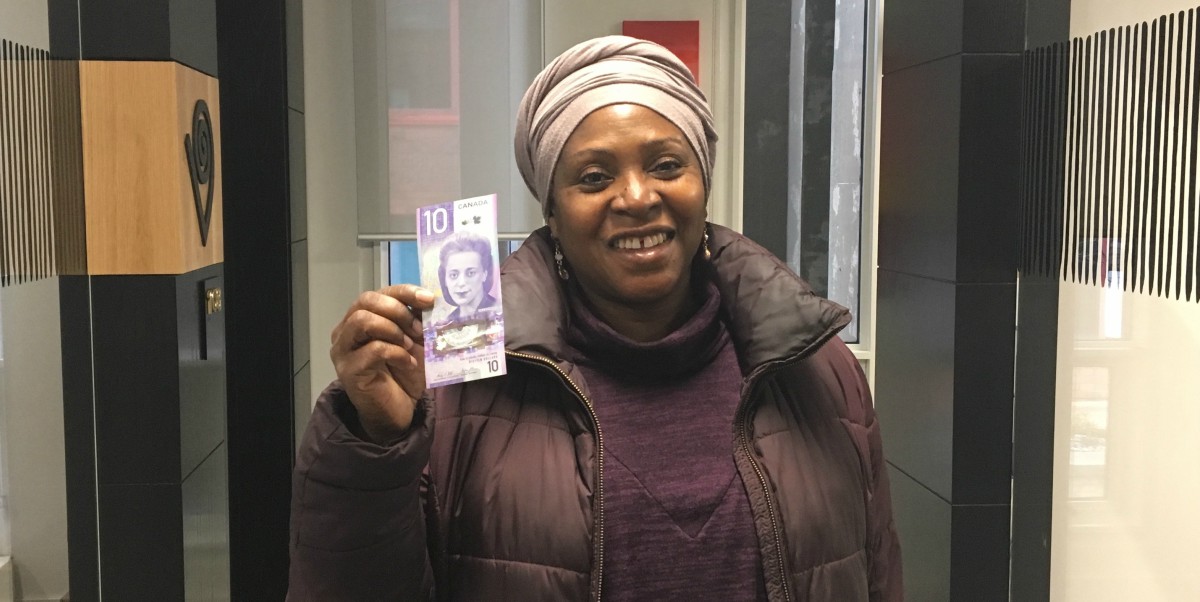Viola Desmond
Halifax celebrates arrival of Viola Desmond $10 bill
Banknote honouring civil rights icon now available

caption
Afua Cooper holds up her new Viola Desmond bill at the Delmore "Buddy" Daye Learning Institute.The Atlantic Canadian celebration of the circulation of the new Viola Desmond $10 bill took place in the same Halifax neighbourhood where Desmond lived.
The conference room at the Delmore “Buddy” Daye Learning Institute was packed with people on Monday looking to honour Desmond.
“Choosing this person, woman of colour, and woman from the north end of Halifax, I think that is just wonderful for the country,” said Rev. Rhonda Britton of New Horizons Baptist Church. “We always say Canada is multicultural, this is just a way of proving it.”
Viola Desmond is a symbol of civil rights in Canada. On Nov. 8, 1946, Desmond went to the Roseland Theatre in New Glasgow to watch a movie while her car was repaired. The theatre was segregated, but Desmond sat in the whites-only section and wouldn’t move when asked to leave. The police were called and Desmond was arrested. She was charged and convicted of not paying one extra penny of theatre tax for the downstairs seat. Related stories
The conviction helped start a civil rights movement in Canada.
Events around the country
Celebrations of the bill entering circulation took place across the country. The official launch, which included Desmond’s sister, Wanda Robson, was in Winnipeg at the Canadian Museum for Human Rights. As part of the launch, bills were given to event attendees, including those at the Buddy Daye Institute. They will start circulating through banks and into general usage later this week.
In March of 2016, Prime Minister Justin Trudeau announced the government was looking for iconic Canadian women to represent on the bill because no Canadian women has ever been on one. There were 461 names submitted and in December of 2016, it was announced that Desmond was selected.
As with the previous $10 bills, the banknote is purple. Unlike its predecessor, Desmond’s face is positioned vertically, instead of horizontally. This is to represent the pursuit of human rights and social justice. The bill also features a map of north-end Halifax.

caption
From left to right: Christine Hanson, Mike Savage, Monique LeBlanc, Marika Parris and Sylvia Parris-Drummond pose with the Viola Desmond bill.Monique LeBlanc from the Bank of Canada and Christine Hanson from the Nova Scotia Human Rights Commission said it’s significant Desmond was chosen for the redesign. Both were in Halifax for the celebration.
LeBlanc said with the bill, every Canadian can carry a brave pioneer who stood up against injustice. Hanson said the new note can be a reminder that it is not always the big moves that bring about change.
‘Vindication of history’
Afua Cooper, a professor of black studies at Dalhousie University and Halifax’s poet laureate, said putting Desmond on the bill honours her legacy.
“It is a vindication of history, a vindication of Viola’s life, her struggle, her gifts and her talents,” said Cooper.
Britton said Desmond being on the bill can be positive for members of the north-end black community.
“Of course, it doesn’t blot out the fact that we face injustice every day, but I think it can help give people hope to say things are changing, and can change, if we can continue to voice what needs to be changed,” she said.
An example of change Britton highlighted is the still vacant Saint Patrick’s Alexandra School on Maitland Street. She would like it to be converted into a community centre. The Halifax Regional Municipality reached a settlement with developers on the school two years ago, but the deal has not been finalized.
Cooper said the new bill shows the country becoming more aware of black people. She sees Desmond as a symbol for diverse groups in Canada.
“She represents courage, compassion, resilience and justice,” said Cooper.


K
Kim Hanson